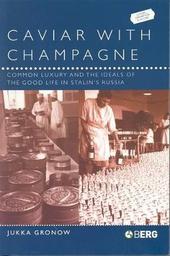
|
Caviar with Champagne: Common Luxury and the Ideals of the Good Life in Stalin's Russia
Paperback / softback
Main Details
| Title |
Caviar with Champagne: Common Luxury and the Ideals of the Good Life in Stalin's Russia
|
| Authors and Contributors |
By (author) Jukka Gronow
|
| Series | Leisure, Consumption and Culture |
|---|
| Physical Properties |
| Format:Paperback / softback | | Pages:256 | | Dimensions(mm): Height 234,Width 156 |
|
| Category/Genre | Cookery, food and drink |
|---|
| ISBN/Barcode |
9781859736388
|
| Classifications | Dewey:947.0842 |
|---|
| Audience | |
|---|
| Illustrations |
20 b&w illustrations, bibliography, index
|
|
Publishing Details |
| Publisher |
Bloomsbury Publishing PLC
|
| Imprint |
Berg Publishers
|
| Publication Date |
1 October 2003 |
| Publication Country |
United Kingdom
|
Description
'Life has become more joyous, comrades.' Josef Stalin, 1936 Stalin's Russia is best known for its political repression, forced collectivization and general poverty. Caviar with Champagne presents an altogether different aspect of Stalin's rule that has never been fully analyzed - the creation of a luxury goods society. At the same time as millions were queuing for bread and starving, drastic changes took place in the cultural and economic policy of the country, which had important consequences for the development of Soviet material culture and the promotion of its ideals of consumption. The 1930s witnessed the first serious attempt to create a genuinely Soviet commercial culture that would rival the West. Government ministers took exploratory trips to America to learn about everything from fast food hamburgers to men's suits in Macy's. The government made intricate plans to produce high-quality luxury goods en masse, such as chocolate, caviar, perfume, liquor and assorted novelties. Perhaps the best symbol of this new cultural order was Soviet Champagne, which launched in 1936 with plans to produce millions of bottles by the end of the decade. Drawing on previously neglected archival material, Jukka Gronow examines how such new pleasures were advertised and enjoyed. He interprets Soviet-styled luxury goods as a form of kitsch and examines the ideological underpinnings behind their production. This new attitude toward consumption was accompanied by the promotion of new manners of everyday life. The process was not without serious ideological contradictions. Ironically, a factory worker living in the United States - the largest capitalist society in the world - would have been hard-pressed to afford caviar or champagne for a special occasion in the 1930s, but a Soviet worker theoretically could (assuming supplies were in stock). The Soviet example is unique since the luxury culture had to be created entirely from scratch, and the process was taken extremely seriously. Even the smallest decisions, such as the design of perfume bottles, were made at the highest level of government by the People's Commissars. Sometimes the interpretation of 'luxury goods' bordered on the comical, such as the push to produce Soviet ketchup and wurst. This fascinating look at consumer culture under Stalin offers a new perspective on the Soviet Union of the 1930s, as well as new interpretations on consumption.
Author Biography
Jukka Gronow is at the Department of Sociology, Uppsala University.
Reviews'Jukka Gronow describes the development in the hungry 1930s of a Soviet rhetoric of cultured living that privileged luxury commodities like champagne, caviar and perfume ... The thorough research in the archives it is based on makes Caviar with Champagne useful to scholars, and general readers will enjoy its vivid illustrations.' London Review of Books 'Jukka Gronow has applied his mastery of the every-day economy and taste cultures to the bewildering world of Stalinist consumerism. In an engaging style, he expertly explains how a luxury goods market came about in a socialist state in the midst of widespread poverty in the 1930s. Both Russians and foreign visitors familiar with Sovetskoe Shampanskoe and the old Soviet department stores and food and fashion shops will enjoy a thrill of discovery about their origins.' Richard Stites, Professor of History, Georgetown University 'An excellent and innovative contribution to the study of consumer culture. By exploring in detail the significance of the emergence of Soviet champagne in the mid 1930s as a way into the broader development of a differentiated Soviet consumer culture - that extends from creating tastes for chocolates, German sausage, caviar, bicycles, etc, to developing new department stores, cafes and canteens - Gronow provides us with new insights into the political economy, stratification, and cultural consciousness of new consumers in the Soviet Union. A richly rewarding exploration of Soviet consumption based upon much hitherto untapped archive material.' David Frisby, Professor of Sociology, University of Glasgow 'Discovering the unknown spaces between politics and consumption in the Stalinist era, Gronow provides a palpable understanding of a civilization that now seems as distant as that of the Aztecs. This brilliant study reveals Soviet champagne as a clue to the 20th century puzzle, exposing its complicity with five-year plans and mass murders. Outstanding in its sensitivity and rejection of stereotypes, this is the best book about Stalin's cultural politics since Timashev's Great Retreat of 1946.' Professor Alexander Etkind, European University at St. Petersburg 'A must-read for anyone interested in Soviet material culture. ...An engaging study, filled with intriguing facts... Gronow's work deserves a place in graduate courses in Soviet history, everyday life, and consumption, as well as a wide readership among scholars in the field.' Julie Hessler, Slavic Review
|